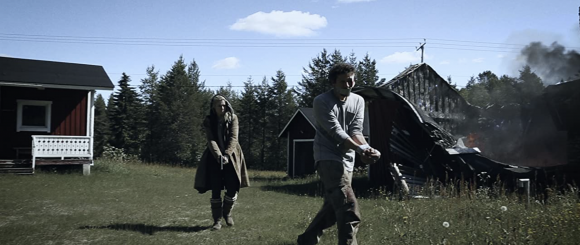Watching A New World Order for New Scientist, 8 September 2021
“For to him that is joined to all the living there is hope,” runs the verse from Ecclesiastes, “for a living dog is better than a dead lion.”
Stefan Ebel plays Thomasz, the film’s “living dog”, a deserter who, more frightened than callous, has learned to look out solely for himself.
In the near future, military robots have turned against their makers. The war seems almost over. Perhaps Thomasz has wriggled and dodged his way to the least settled part of the planet (Daniel Raboldt’s debut feature is handsomely shot in Arctic Finland by co-writer Thorsten Franzen). Equally likely, this is what the whole planet looks like now: trees sweeping in to fill the spaces left by an exterminated humanity.
You might expect the script to make this point clear, but there is no script; rather, there is no dialogue. The machines (wasp-like drones, elephantine tripods, and one magnificent airborne battleship that that would not look out of place in a Marvel movie) target people by listening out for their voices; consequently, not a word can be exchanged between Thomasz and his captor Lilja, played by Siri Nase.
Lilja takes Thomasz prisoner because she needs his brute strength. A day’s walk away from the questionable safety of her log cabin home, there is a burned-out military convoy. Amidst the wreckage and bodies, there is a heavy case — and in the case, there is a tactical nuke. Lilja needs Thomasz’s help in dragging it to where she can detonate it, perhaps bringing down the machines. While Thomasz acts out of fear, Lilja is acting out of despair. She has nothing more to live for. While Thomasz wants to live at any cost, Lilja just wants to die. Both are reduced to using each other. Both will have to learn to trust again.
In 2018, John Krasinski’s A Quiet Place arrived in cinemas — a film in which aliens chase down every sound and slaughter its maker. This cannot have been a happy day for the devoted and mostly unpaid German enthusiasts working on A New World Order. But silent movies are no novelty, and theirs has clearly ploughed its own furrow. The film’s sound design, by Sebastian Tarcan, is especially striking, balancing levels so that even a car’s gear change comes across as an imminent alien threat. (Wonderfully, there’s an acknowledging nod to the BBC’s Tripods series buried in the war machines’ emergency signal.)
Writing good silent film is something of a lost art. It’s much easier for writers to explain their story through dialogue, than to propel it through action. Maybe this is why silent film, done well, is such a powerful experience. There is a scene in this movie where Thomasz realises, not only that he has to do the courageous thing, but that he is at last capable of doing it. Ebel, on his own on a scree-strewn Finnish hillside, plays the moment to perfection.
Somewhere on this independent film’s long and interrupted road to distribution (it began life on Kickstarter in 2016) someone decided “A Living Dog” was too obscure a film title for these godless times — a pity, I think, and not just because “A New World Order”, the title picked for UK distribution, manages to be at once pompous and meaningless.
Ebel’s pitch-perfect performance drips guilt and bad conscience. In order to stay alive, he has learned to crawl about the earth. But Lilja’s example, and his own conscience, will turn dog to lion at last, and in a genre that never tires of presenting us with hyper-capable heroes, it’s refreshing, on this occasion, to follow the forging of one courageous act.

